What part does luck play in the success or otherwise of community programmes? Those of us who work in development would probably not admit to much. But sometimes the bad luck that affects the rural poor would make you cry.
Last week I visited a rural development programme which assists nine communities on the slopes of Telica volcano, in Western Nicaragua. Local NGO Nuevas Esperanzas has been doing great work here for the last ten years, improving access to water, gradually working to diversify crops and diet in the zone and, if possible, to look for income generation activities.
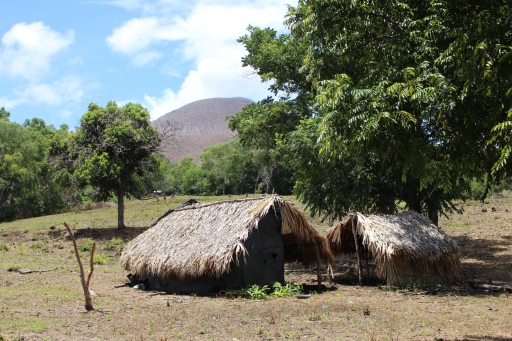
Agua Fria housing with the volcano in the background
‘These villages are very isolated’, Carlos told us, as we bumped along in a pick-up filled with fertiliser and other agricultural inputs. This became apparent as we climbed steadily up the slopes of Telica, an occasionally active volcano. As we came within a few hundred metres from the summit I asked myself why farmers would want to live up here. Sadly though, all over the world we find the poorest people have to live on the most marginal lands. In some cases putting themselves in danger, on the edges of rivers, near hazards, and on flood plains. The same in Central America, the poorest peasants make their homes on steep slopes while the better-off farmers have captured the good land in the valley bottom.
Agronomists from Nuevas Esperanzas spent the day advising farming families on new methods and new crops, to add variety to the standard crops of maize and beans. Small farmers groups are experimenting with pineapple and dragon fruit. We visited three ‘model farms’, and came away with some of the new fruit. But there are no magic bullets in development, and all new crops are approached with caution by campesinos with limited access to land.
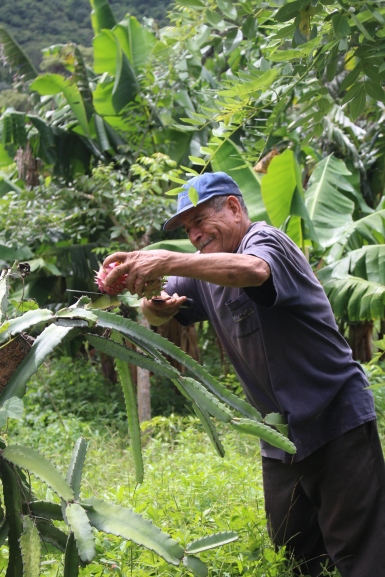
The new fruits can be used locally for juice – the vitamins are good for children’s diets and development. But small farmer tastes are conservative in Nicaragua, and some families have said they ‘don’t like it’. If the dragon fruit won’t be drunk by local families, can it be sold? Not easily, not when the nearest market is 40km away and your only transport is a horse. There are solutions to all these problems, but they will take some ingenuity, and crucially, the local people have to be convinced that the benefits of fruit make it worthwhile to set aside some of their precious land and labour.
We saw some excellent water systems, where communities and engineers have brought fresh water from many kilometres away. And many houses and churches now have rainwater harvesting tanks. Maria Eugenia told me she has had hers for four years now and it lasts the family for three months into the dry season. That is 3 months in which her children don’t have to make an hour long round trip on a horse to bring back four small water containers from the spring.
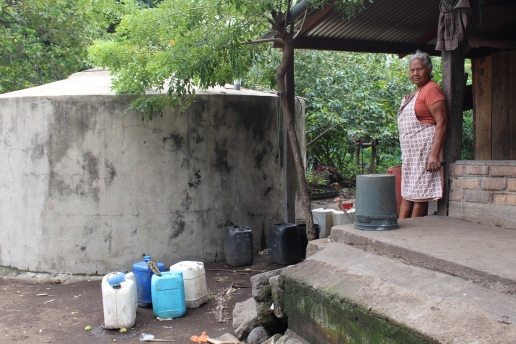
And so on to the great new hope: Tourism. Tourism is a growing industry and many visitors come on day-trips from the town of Leon. But they bring everything with them from the town, the guide, their lunch, and drinks. The tourist trade at present brings little benefit to local people. After consultation with the community, Nuevas Esperanzas embarked on their largest project, to build a hostel and café. If visitors ate in the region, and slept overnight so they could see the dawn, then significant benefit would come to the local people, bringing employment for guides, cooks, local produce etc.
The site of the hostel was chosen carefully. The volcano does occasionally throw out rocks (incandescent ballistic projectiles as they are technically known) – but never this far from the crater. ‘Speaking to local people, they told us that never in memory (50+ years) had rocks landed in this area’. Telica has had small eruptions on and off over the years but never affected this site.
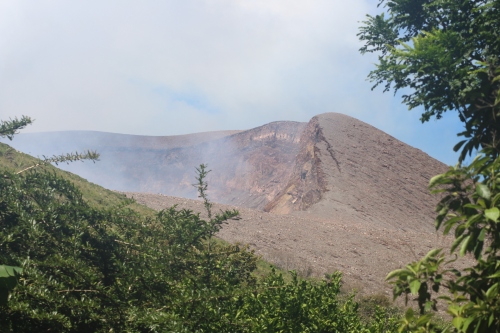
The project was a success, funded by the European Union, and the building was finished in November. The EU sent an auditor on a Monday, who saw the work was good, and signed off the project as finished. What could possibly go wrong?
So yes, you guessed it. The following day, at 9 in the morning, bang! Telica active, ash spewing out, land shaking, and then a crash, as rocks as big as buckets were shot out by the volcano – towards the hostel and the community. Incredibly over fifteen rocks hit the hostel directly, landing on the roof, smashing holes in it, smashing the cement of the water tank. Bad luck for the community of Agua Fria? Or good luck because no-one was sleeping there yet, no one was killed.
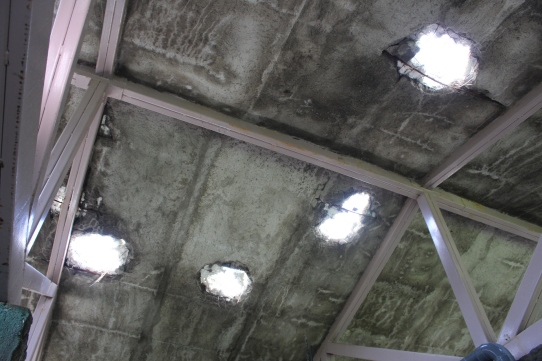
Looking up at the roof of the hostel/cafe
The event was not only unheard of for Telica, it appears to be one of the most extreme events of its kind (phreatic eruption with large projectiles) reported anywhere. Rocks weighing at least 4 tonnes travelled (airborne) more than 400 metres from the crater and smaller rocks reaching over 1.5 km. For more details on a similar event see YouTube
The volcanic activity lasted 15 minutes, but that was long enough to kill the project dead. The building sits there today, a shell that can’t now be used because the government has declared it is too dangerous. The community members ran for their lives that day, and later returned to their homes where they remain today. If you are poor in Nicaragua you have little choice as to where you can live.
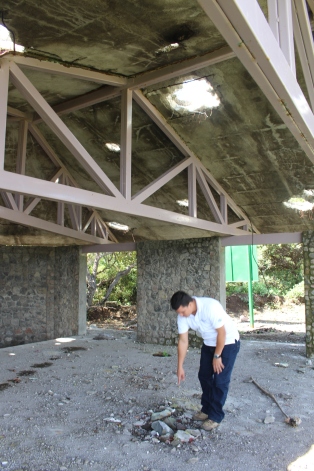
So there ends the tale…Or does it? The tourists keep coming – they are wise enough to assess risk, work out the probabilities. They do the same before bungee jumping or white-water rafting. So the Leon travel companies keep making money. Some of the community are now saying that they were unlucky once, they couldn’t possibly be unlucky again. “Patch up the roof of the hostel and let’s get going” says one. It might have to be illegal for a year or so at the beginning, because of the safety regulations. “But most new businesses in Nicaragua are illegal at the beginning”. Things sort themselves out later if the business is a success.
What option to take, to leave it closed or try again? Maybe some local underemployed young people might be prepared to cut some corners and take the risk. Maybe the new business can bring a sustainable income stream into the community. But a legally-registered NGO would have to think twice, or more, before taking that risk. What would you do?
Please use the Comments tab to give us your views…
This really was amazing to see. What a shame for the community and the tourist centre. Hopefully something will be done with the building, but I must admit, I’d feel nervous sleeping there!! Good projects otherwise in a very remote area.
LikeLike
Eesh! That’s a tough choice isn’t it. I’m quite superstitious about bad luck and would be worried it would happen again. If even one person was injured, that would be the end. And could bring huge costs and bad effects for the community. But I can totally see why they’d be tempted….
Could the (highly improbable) eruption be turned into an advantage? Could vulcanologists be persuaded to set up in the hostel with a research site? Or could it be explicitly ‘Volcano tourism’? I feel very ignorant…
LikeLiked by 1 person
I suspect (as another resident of Nicaragua, also living not far from a volcano) that Telica is simply too unpredictable. The ejections of rocks seem to be occurring more frequently, and if I wanted to climb it I’d be happier not staying close to it overnight. As you say though, Steve, local people have little choice, even though their memories of the destructive power of volcanoes are doubtless very strong (the nearby Casitas volcano produced a mudslide in 1998, as a result of Hurrican Mitch, which wiped out numerous small settlements of the kind that appear in Steve’s photos).
LikeLiked by 1 person
I like the idea of volcano tourism. Then the tourists know in advance that there may be a risk. Or the community could patch up the roof and use it as a community building for meetings, celebrations, events etc. They could collect rainwater from the tin roof if it has gutters.
LikeLiked by 1 person
I do wish the story had explained just how to get to the community and if their are locals that would put up guests for the night for a fee. And no places to eat there or and pulperias?
LikeLiked by 1 person
Your post about the volcano and the hostel/cafe was heart breaking. It was a blessing, of course, that there were no casualties. I watched the you tube footage and those enormous rocks were not only heavy but very, very hot. It could have been carnage.
If such an eruption had not happened in 50+ years I can imagine that It would be very tempting to go ahead with using the hostel and ignore the risk of such a thing happening again.
It’s a hard life in Agua Fria, that’s for sure.
LikeLiked by 1 person
Jorge Dominguez
This has no potential with couch potato tourists. But with tourists that are like to explore and see new things, I’ll say it has lots of potential.
Rebecca Brown
Most people in North America get a two week vacation which means that most of them want something relaxing where they’re catered to. Adventure tourists tend to be either much younger (and taking a gap year isn’t common in the US) or retired or rich.
Rebecca Brown
People build and farm up to the lava beds on active volcanos because the land formed by not that recent volcanic activity is very fertile.
LikeLike
I would recommend teaching folks from the village how to prepare food to the standard for American guests taking advantage of the fruits and vegetables that they are cultivating. They could learn how to prepare the food to avoid folks getting sick and then advertise with the guides coming from Leon. If lunch was ordered in advance then it wouldn’t be something they would have to lose money on to purchase food and prepare if no one ended up coming. This also doesn’t require an investment in a huge amount of infrastructure.
LikeLike